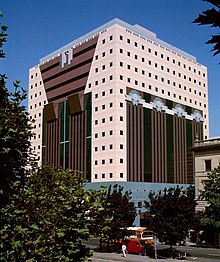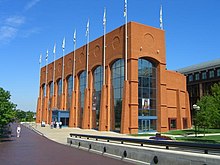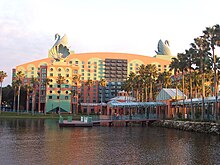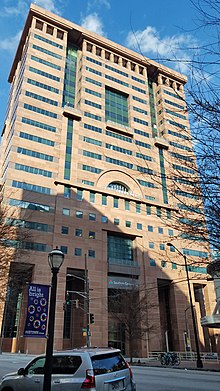Michael Graves
Graves' global portfolio of architectural work ranged from the Ministry of Culture in The Hague, a post office for Celebration, Florida, a prominent expansion of the Denver Public Library to numerous commissions for Disney and the scaffolding design for the 2000 Washington Monument restoration.
[5] For his architectural work, Graves received a fellowship of the American Institute of Architects as well as its highest award, the AIA Gold Medal (2001).
Graves produced both high end and mass consumer product designs for several companies, including Alessi in Italy and Target and J. C. Penney in the United States.
[1] The New York Times described Graves as "one of the most prominent and prolific American architects of the latter 20th century, who designed more than 350 buildings around the world but was perhaps best known for [a] teakettle and pepper mill.
[1][7] Graves graduated from Indianapolis's Broad Ripple High School in 1952 and earned a bachelor's degree in architecture in 1958 from the University of Cincinnati.
During a career that spanned nearly fifty years, Graves and his firm designed more than 350 buildings around the world, and an estimated 2,000 household products.
In 1964 he founded the architectural firm of Michael Graves & Associate in Princeton and remained in public practice there until the end of his life.
[26] This informal group of Princeton and New York City architects, also known as the Whites due to the predominant color of their architectural work, espoused a pure form of modernism characterized by clean lines and minimal ornamentation.
[1][28] The San Juan Capistrano Library (1982) in California, another project from this period, shows his interpretation of the Mission Revival style.
[10] Patrick Burke, the project architect for the two resort hotels in Florida, commented that the Walt Disney Company described Graves's designs as "entertainment architecture.
"[33] In addition to the Swan and Dolphin hotel buildings, Graves's firm designed their original interiors, furnishings, signage, and artwork.
[34] Graves's other notable commissions for buildings that were completed in the 1990s include an expansion of the Denver Public Library (1990) and the renovation of the Detroit Institute of Arts (1990).
For example, his design for an expansion of Marcel Breuer's Whitney Museum of American Art building in New York City in the mid-1980s was highly contested and never built due to architect and local opposition.
[1] Graves's designs for a planned Phoenix Municipal Government Center complex were among the project's finalists, but his concept was not selected as the winning entry.
Later works include the O'Reilly Theater (1996) in Pittsburgh, Pennsylvania; the NCAA Hall of Champions in Indianapolis, Indiana; and 425 Fifth Avenue (2000) in New York City, among others.
His distinctive style was well known among the general public in the United States in 1980s and 1990s, when he began designing household products for major clients such as the Target Corporation, Alessi, Steuben, and The Walt Disney Company.
[4][39] In the early 1980s, Ettore Sottsass recruited Graves to become a member of Memphis, a postmodern design group based in Milan, Italy.
Graves designed a sterling silver tea service for Alessi in 1982, a turning point in his career, and he was no longer known solely as an architect.
After the $25,000 tea service began to attract buyers, Alberto Alessi commissioned Graves to design a moderate-priced kettle for his company.
In honor of its thirtieth anniversary in 2015, Graves designed a special edition version with a dragon replacing the kettle's bird-shaped whistle.
[45] Increasingly concerned about Target's dwindling partnerships with outside designers, Graves decided to explore other relationships for marketing his consumer products.
In the 1990s for example, Graves created the Mickey Mouse Gourmet Collection for Moeller Design with the Walt Disney Company's approval.
[47] In addition to housewares, Graves was involved in a variety of other design projects that included sets and costumes for New York City's Joffrey Ballet; a shopping bag for Bloomingdale's department store; jewelry for Cleto Munari of Milan, Italy; vinyl flooring for Tajima, a Japanese company; and rugs for Vorwerk, a German firm.
When Graves became paralyzed from the waist down in 2003, the result of a spinal cord infection, the use of a wheelchair heightened his awareness of the needs of the disabled.
After weeks of hospitalization and physical therapy, Graves adapted his home to suit his accessibility needs and resumed his architectural and design work.
[1] As an advocate for the needs of the disabled, Graves used his skills as an architect and designer "to improve healthcare experience for patients, families and clinicians.






















